
The Plymouth Cordage Company was a rope making company located in Plymouth, Massachusetts.

The Plymouth Cordage Company was a rope making company located in Plymouth, Massachusetts.
The company, founded in 1824, had a large factory located on the Plymouth waterfront. By the late 19th century, the Plymouth Cordage Company had become the largest manufacturer of rope and twine in the world. [1] The company specialized in ship rigging, and was chosen among other competitors in the early 1900s to manufacture the rope used on the USS Constitution. The company's twine, Plymouth binder twine, popular among farmers, was the inspiration for the naming of the Plymouth brand of automobiles first produced in 1928. In the 1910s, its mill was the world's largest of its kind. [2]
The Plymouth Cordage Company served as the largest employer in Plymouth for over 100 years. It went out of business in 1964 after over 140 years of continuous operation. [3] By the early-1960s, it had bought all the materials needed for production, had no debt and a lot of cash and was bought out by the Columbian Rope Company in 1965.
In January 1916, the company was seeing increased business in their busiest season, preparing twine for both local harvest and foreign countries at war. When wages stayed stagnant despite rising costs of living, Cordage workers, despite not being unionized, spontaneously walked out in the company's first strike, halting company-wide production. Local anarchists from Boston traveled to support the strike, including Luigi Galleani and Bartolomeo Vanzetti, who formerly worked at the factory and later blamed his staunch participation in the strike for being blacklisted in the region. Historians contest that the strike had such an effect on workers. After a month-long closure, the factory offered a modest increase in wages below the strike demand, to which the workers accepted and returned. [4]
Upton Sinclair's historical novel "Boston" has several chapters devoted to the company when his elderly heroine goes to work for the factory.
Plymouth Cordage also operated a factory in Welland, Ontario. A detailed history of Welland operations can be found at the Welland Public Library Local History site. [5]

In modern times, the 45-acre (180,000 m2) Cordage factory property in North Plymouth has been turned into a large retail and office center. The building, now known as Cordage Commerce Center, houses the Plymouth MBTA station, a terminus for the Old Colony Line. The factory also contains several restaurants, offices, and stores. University of Massachusetts Boston currently offers some classes in a wing of the building. The largest retailer is Mill Stores, which has now been closed. There was previously a Wal-Mart located on the property, but it closed in 2005 and relocated to Colony Place, also in Plymouth.
In 2012, much of the former plant was demolished due to deterioration related to the quick construction of the facility in 1899. Plans for the site include the eventual building of condominiums. [6]
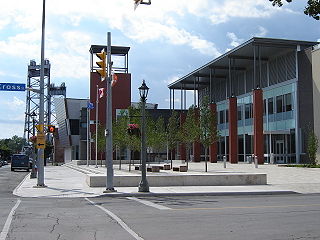
Welland is a city in the Regional Municipality of Niagara in Southern Ontario, Canada. As of 2021, it had a population of 55,750.

Plymouth is a town and county seat of Plymouth County, Massachusetts, United States. Located in Greater Boston, the town holds a place of great prominence in American history, folklore, and culture, and is known as "America's Hometown". Plymouth was the site of the colony founded in 1620 by the Mayflower Pilgrims, where New England was first established. It is the oldest municipality in New England and one of the oldest in the United States. The town has served as the location of several prominent events, one of the more notable being the First Thanksgiving feast. Plymouth served as the capital of Plymouth Colony from its founding in 1620 until the colony's merger with the Massachusetts Bay Colony in 1691. The English explorer John Smith named the area Plymouth and the region 'New England' during his voyage of 1614. It was a later coincidence that, after an aborted attempt to make the 1620 trans-Atlantic crossing from Southampton, the Mayflower finally set sail for America from Plymouth, England.

Nicola Sacco and Bartolomeo Vanzetti were Italian immigrant anarchists who were controversially convicted of murdering Alessandro Berardelli and Frederick Parmenter, a guard and a paymaster, during the April 15, 1920, armed robbery of the Slater and Morrill Shoe Company in Braintree, Massachusetts, United States. Seven years later, they were executed in the electric chair at Charlestown State Prison.
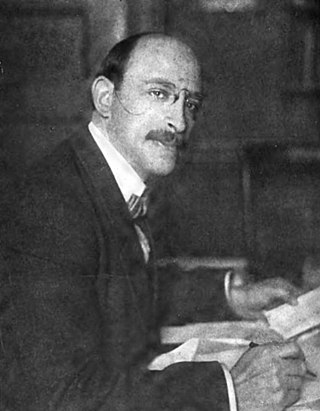
Alexander Berkman was a Russian-American anarchist and author. He was a leading member of the anarchist movement in the early 20th century, famous for both his political activism and his writing.

The Wall Street bombing was an act of terrorism on Wall Street at 12:01 pm on Thursday, September 16, 1920. The blast killed thirty people immediately, and another ten died later of wounds sustained in the blast. There were 143 seriously injured, and the total number of injured was in the hundreds.

The first Red Scare was a period during the early 20th-century history of the United States marked by a widespread fear of far-left movements, including Bolshevism and anarchism, due to real and imagined events; real events included the Russian 1917 October Revolution and anarchist bombings in the U.S. At its height in 1919–1920, concerns over the effects of radical political agitation in American society and the alleged spread of socialism, communism, and anarchism in the American labor movement fueled a general sense of concern.
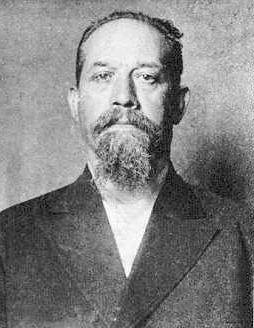
Luigi Galleani was an Italian insurrectionary anarchist best known for his advocacy of "propaganda of the deed", a strategy of political assassinations and violent attacks.
In the United States, anarchism began in the mid-19th century and started to grow in influence as it entered the American labor movements, growing an anarcho-communist current as well as gaining notoriety for violent propaganda of the deed and campaigning for diverse social reforms in the early 20th century. By around the start of the 20th century, the heyday of individualist anarchism had passed and anarcho-communism and other social anarchist currents emerged as the dominant anarchist tendency.

The Preparedness Day Bombing was a bombing in San Francisco, California, United States, on July 22, 1916, of a parade organised by local supporters of the Preparedness Movement which advocated American entry into World War I. During the parade a suitcase bomb was detonated, killing 10 and wounding 40 in the worst terrorist attack in San Francisco's history.
Webster Thayer was a judge of the Superior Court of Massachusetts, best known as the trial judge in the Sacco and Vanzetti case.
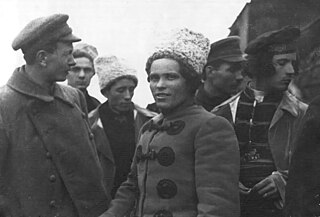
Anarchism in Ukraine has its roots in the democratic and egalitarian organization of the Zaporozhian Cossacks, who inhabited the region up until the 18th century. Philosophical anarchism first emerged from the radical movement during the Ukrainian national revival, finding a literary expression in the works of Mykhailo Drahomanov, who was himself inspired by the libertarian socialism of Pierre-Joseph Proudhon. The spread of populist ideas by the Narodniks also lay the groundwork for the adoption of anarchism by Ukraine's working classes, gaining notable circulation in the Jewish communities of the Pale of Settlement.

The Amoskeag Manufacturing Company was a textile manufacturer which founded Manchester, New Hampshire, United States. From modest beginnings it grew throughout the 19th century into the largest cotton textile plant in the world. At its peak, Amoskeag had 17,000 employees and around 30 buildings.

Peoria Cordage Company was a major manufacturer of twine and cords, It operated in Peoria, Illinois for almost a century.
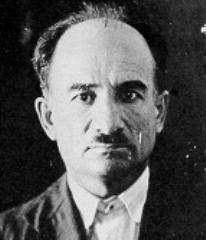
Mario Buda (1883–1963) was an Italian anarchist active among the militant American Galleanists in the late 1910s and best known for being the likely perpetrator of the 1920 Wall Street bombing, which killed 40 people and injured hundreds. Historians implicate Buda in multiple bombings, though the documentary evidence is insufficient to prove his responsibility.
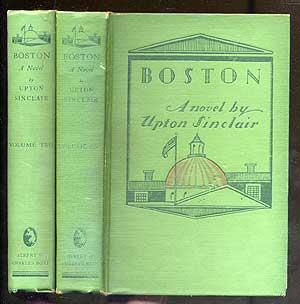
Boston is a novel by Upton Sinclair. It is a "documentary novel" that combines the facts of the case with journalistic depictions of actual participants and fictional characters and events. Sinclair mixed his fictional characters into the prosecution and execution of Sacco and Vanzetti.
Iosif Solomonovich Bleikhman was a Belarusian Jewish anarchist communist revolutionary. He was the leader of the Petrograd Federation of Anarchist-Communists at the time of the Russian Revolution in 1917, organising a series of demonstrations against the Russian Provisional Government that culminated in the July Days. Following the October Revolution, he also began to agitate against the new Bolshevik government, which resulted in him being arrested and sentenced to periods of penal labor a number of times. During one of these periods, he contracted tuberculosis, which he succumbed to shortly before the Kronstadt rebellion of 1921.

The Milwaukee Police Department bombing was a November 24, 1917, bomb attack that killed nine members of local law enforcement and a civilian in Milwaukee, Wisconsin, United States. The perpetrators were never caught but are suspected to be an anarchist terrorist cell operating in the United States in the early 20th century. The target was initially an evangelical church in the Third Ward and only killed the police officers when the bomb was taken to the police station by a concerned civilian. The bombing remained the most fatal single event in national law enforcement history for over 80 years until the September 11 attacks.
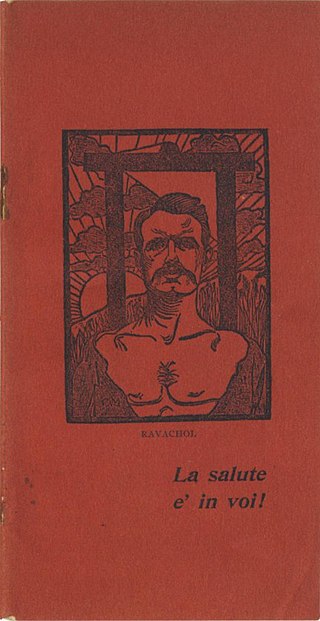
La Salute è in voi! was an early 1900s bomb-making handbook associated with the Galleanisti, followers of anarchist Luigi Galleani, particularly in the United States. Translated as "Health Is in You!" or "Salvation Is within You!", its anonymous authors advocated for impoverished workers to overcome their despair and commit to individual, revolutionary acts. The Italian-language handbook offered plain directions to give non-technical amateurs the means to build explosives. Though this technical content was already available in encyclopedias, applied chemistry books, and industrial sources, La Salute è in voi wrapped this content within a political manifesto. Its contents included a glossary, basic chemistry training, and safety procedures. Its authors were likely Galleani and his friend Ettore Molinari, a chemist and anarchist.

Galleanisti are followers or supporters of the insurrectionary anarchist Luigi Galleani, who operated most notably in the United States following his immigration to the country. The vast majority of Galleanisti or Galleanists were similarly poor and working class Italian immigrants or Italian Americans, and especially Italian anarchists and Italian immigrants or Italian-Americans involved in the labor movement of the time. Galleanists remain the primary suspects in a campaign of bombings between 1914 and 1920 in the United States.

Downs & Son was a rope and twine manufacturing firm located in Brunswick, Victoria, Australia, which operated the Samson Cordage Works factory in Brunswick. The factory was the oldest and last surviving rope works in the northern suburbs of Melbourne, and the best surviving in Melbourne.